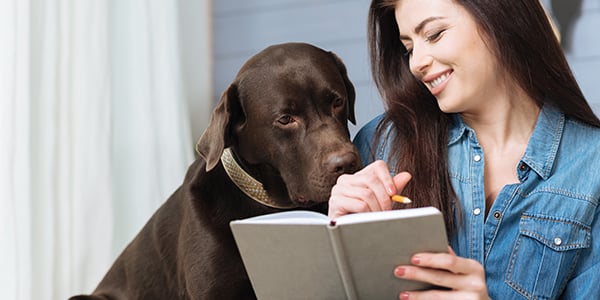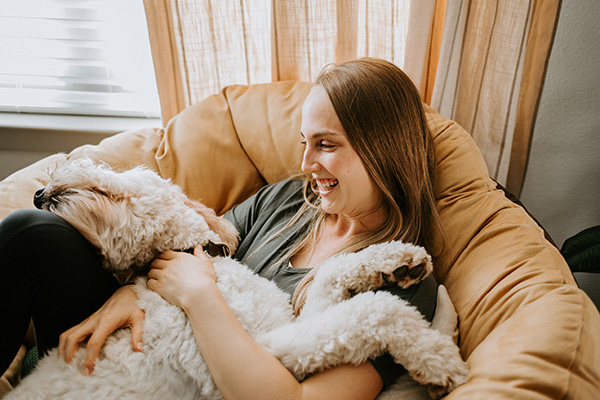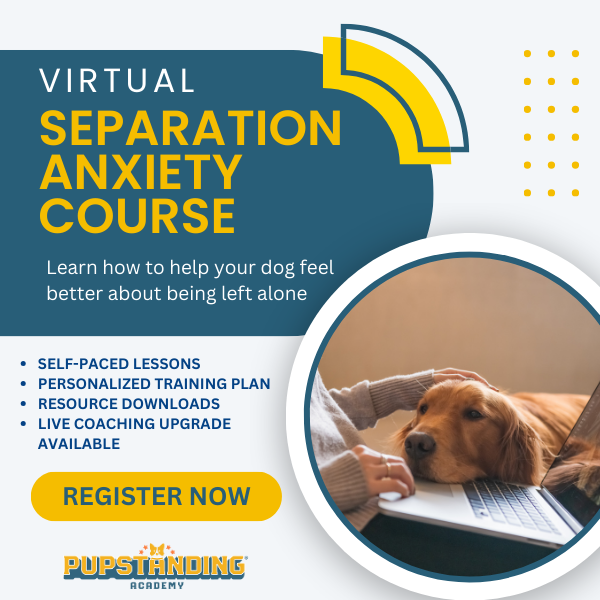 Starting the journey of treating your dog's separation anxiety can feel overwhelming. Treating separation anxiety involves a commitment of time and effort, and often requires investment in expensive management tools and resources.
Starting the journey of treating your dog's separation anxiety can feel overwhelming. Treating separation anxiety involves a commitment of time and effort, and often requires investment in expensive management tools and resources.
But the results of effective anxiety treatment are well worth it. Your dog will be able to spend time alone safely and without stress. Your neighbors won't complain about constant barking, and your couch or other household items won't be torn to shreds due to destructive anxiety symptoms.
A certified dog trainer, behavior consultant, or veterinary behaviorist can start you off on the right path. They will work with you to create a behavior and training plan to tackle your dog's anxiety. This plan will include what's called absence suspension and counter conditioning and desensitization.
Before you begin any counter conditioning or desensitization training, you’ll need to figure out how to make absence suspension work for your life. This means figuring out how to never leave your dog alone in the first place. This part of the plan is the toughest but, with a little planning, you can do it!
What Is Absence Suspension?
Absence suspension means never leaving your dog alone for longer than they can handle. This is done at the beginning of separation anxiety treatment for a few reasons.
- It prevents your dog’s anxiety symptoms from happening in the first place.
- Your dog’s brain and body are getting a much-needed reset. When anxiety spikes, stress hormones are being released and flooding their brain. If they are not left alone, this gives your dog’s body time to return to a normal and calmer state.
- It keeps your dog under threshold. Staying sub-threshold is imperative to be able to implement effective counter conditioning and desensitization training.
What is a Dog's Threshold?
"Threshold" is a term used in dog behavior to mean the level at which a dog can cope with a specific stimulus. For example, one dog’s threshold for being alone might be five minutes. After five minutes, the dog exhibits separation anxiety symptoms. Staying under threshold means that the dog is not left alone longer than five minutes.
Absence suspension is a management tool, not a treatment for your dog’s anxiety in and of itself. It is essentially removing the trigger for your dog’s anxiety but must be paired with creating a positive association with being alone (counter conditioning), and slowly increasing the amount of time your dog spends by themselves (desensitization).
Without these things, your dog will never learn how to be alone for more extended periods. When done correctly though, you will eventually be able to leave your dog alone!
How to Start Absence Suspension When Treating Your Dog’s Separation Anxiety
Identify Your Dog's Threshold for Being Alone
This is where having the help of a certified professional really comes in handy. A trainer can help you identify signs that your dog is beginning to feel anxious about being left alone. For some dogs, this means they will start to shadow you when you brush your teeth (because that always precedes you leaving for work). Another dog might get anxious right after you walk out the door. For others, signs of anxiety might be pacing or acting restless when they’ve been alone for a certain amount of time.
Every dog is different. Set up a video camera to monitor your dog while they are alone so you can track their behavior and note when their anxiety begins. Once you know your dog’s anxiety threshold, you’ll be able to plan ahead for the times that you’ll need to leave them alone longer than they can handle.
 Grab Your Calendar and Schedule
Grab Your Calendar and Schedule
Mark the times that you know you will be gone for longer than your dog can deal with. Create a schedule so you know when you will need help watching your dog. If it's an option, consider working from home, even if it's just a few days a week. Some dogs don't experience separation anxiety when they are in the car, so consider taking them along when you run errands or go to the gym (but never when it's too cold or warm outside!).
Find Help!
It really does take a village. Do you have any friends, family members, or neighbors that could stay with your dog at certain times? Someone who lives close where you could drop your dog off while you head out?
Reach out to people in your local community to see if anyone would be willing to hang out with them while you're gone. Your dog trainer or veterinarian can also connect you with helpful local resources for when you need to be gone longer than what your dog can handle.
- Dog Walkers: If your dog has a higher threshold for being alone, hire a dog walker to take them out for some exercise and playtime before they begin to get anxious.
- Pet Sitters: Many pet sitters are available for daytime pet sitting, not just overnight care. Some offer pet sitting in their home, while others can spend the day at your place.
- Dog Daycare: Daycare can work for some dogs that suffer from anxiety, but in some cases, it can make anxiety worse. This depends on whether your dog suffers from isolation distress (anxious about being alone but okay when there is someone around) or separation anxiety (anxious when separated from a particular person or persons). Some dogs don't enjoy being around other dogs, which makes daycare unsuitable. Work with your local dog daycare to determine if your dog enjoys it, and their anxiety isn't made worse by being away from you.

Once you've made a plan for keeping your dog under their anxiety threshold, your counter conditioning and desensitization training will be more effective. The more effective this treatment is, the faster your dog can overcome separation anxiety.
When done correctly, your dog should be able to cope with being alone for increasingly longer periods. Make sure you have a supportive team around you that includes your certified dog trainer or behavior consultant and your veterinarian or a veterinary behaviorist. They’ll be able to walk you through how to implement a behavior plan that includes counter conditioning and desensitization for your dog’s anxiety.
For helping your dog with separation anxiety, and to answer any questions you have, click below to explore booking one-on-one sessions with me. I'm a certified dog trainer and behavior consultant.





